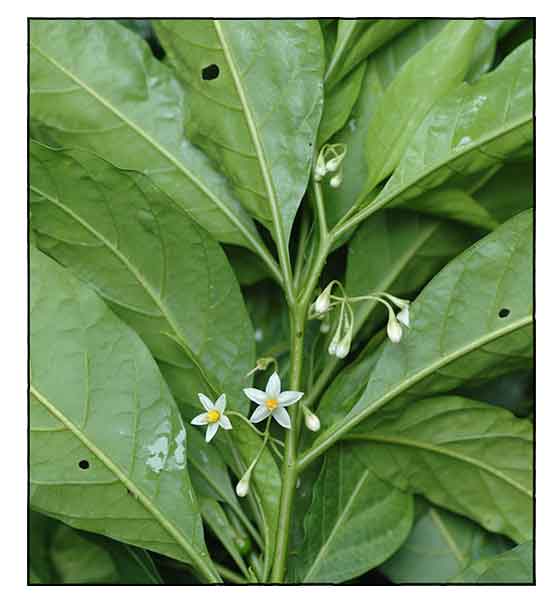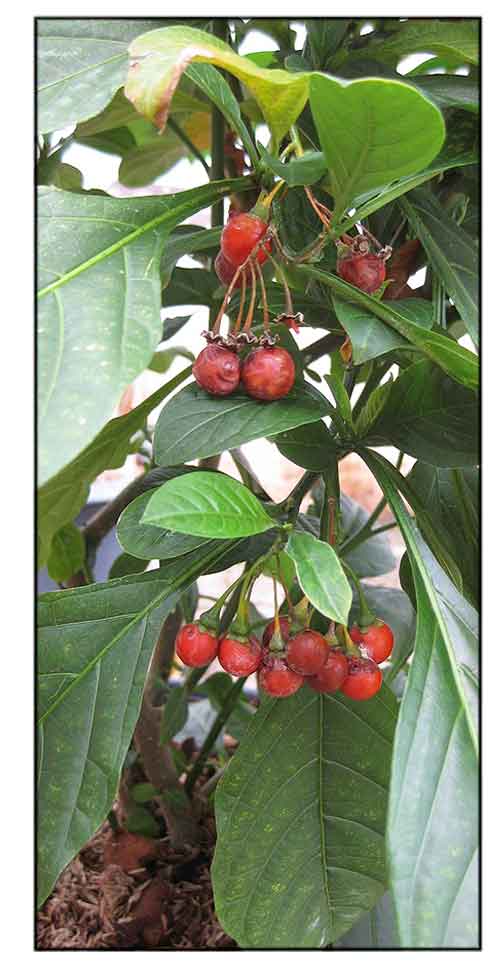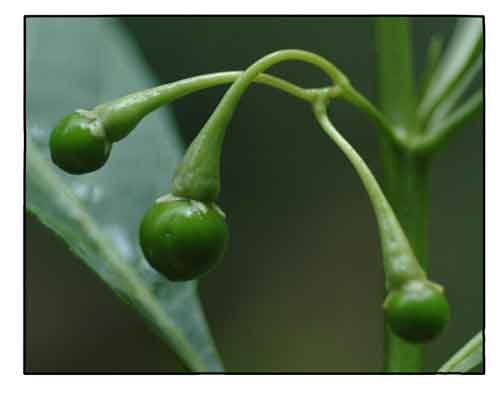 Gen info Gen info
- Solanum is a large and diverse genus of flowering plants. which include three food crops of high economic importance: the potato, the tomato, and the eggplant. It is the largest genus in the nightshade family Solanaceae, comprising about 1,500 species. (14)
- The genus name Solanum was first used by Pliny the Elder (AD 23-79) for a plant known as strychnos, most likely S. nigrum. The derivation is uncertain, possible from the Latin word sol, meaning "sun", referring to its status as a plant of the sun. (14)
-
Solanum spirale is a small fruiting shrub in the family Solanaceae.
Botany
• Shrub to 3 m, green, glabrous except for simple hairs mainly in tufts in axils of main veins of lower leaf-surface; prickles absent. Leaves: Leaves lanceolate-elliptic; lamina 7–18 cm long, 2–2.5 cm wide, concolorous, entire; petiole 1–2.5 cm long, grooved above, narrowly winged almost to base. Flowers: Inflorescence short, 5–10 (occasionally to 30)-flowered; peduncle 2–10 mm long; pedicels 10–15 mm long, slightly longer in fruit. Calyx 2–3 mm long; lobes rounded, 0.5–1 mm long. Corolla deeply incised, to 15 mm diam., white. Anthers 2–3 mm long. Fruit: Berry globular, 10–15 mm diam., bright orange-yellow. Seeds 3–4 mm long, light yellow-brown, the margin slightly thickened. (3)
• Solanum spirale is an undershrub up to 12 ft. high plant; stem erect with 1 or 2 sharp ridges. Leaves are 2-7 by .8-3 inch, (each leaf is subtended by a small leaf often much reduced.), elliptic, entire, acute, membranous, glabrous; lateral nerves about 7 on either half; base alternate; petiole .6 in. long; Flowers are white, small and dense, spirally arranged, racemose, extra axillary, inflorescence. Ripe berries are orange-red in colour, globose, .3 inch in diameter. (4)
Distribution
- Native to the Philippines. (1)
- Found in Mindanao: Bukidnon, Davao, Davao del Sur.
- In damp forested ravines, up to 1,500 m.
- Listed as introduced by POWO (Plants of the World Online) (2)
- Also native to Assam, Bangladesh, China South-Central, China Southeast, East Himalaya, Jawa, Laos, Myanmar, Sumatera, Thailand, Tibet, Vietnam. (2)
 Constituents Constituents
- Methanol extracts yielded phenolic content of 18.64 mg GAE/g and 11.72 mg GAE/g in shoot and mature berry, respectively; and flavonoid content of 5.29 µM RE/g and 50.52 µM RE/g in shoot and mature berry, respectively. (see study below) (4)
- GC-MS study of fruits for essential oil
identified 29 constituents, constituting 82.11% of total chromatographical oil components. Major components were n-hexadecanoic acid (56.01%), linolelic acid (9.71%), octadecanoic acid (4.41%), methyl palmitate (1.69%), tetradecanoic acid (1.55%), (E)-phytol (1.18%), n-hexanal (0.91%), methyl salicylate (0.83%), 4-hydroxy-4- methylpentan-2-one (0.81%), pentadecanoic acid (0.71%) and β-selinene (0.56%). (see study below) (8)
- GC-MS of ethanol extract of Solanum spirale shoots for phytochemical composition, mineral content and proximate composition
yielded a total of 40 phytochemicals. Mineral content yielded 0.115 (Fe), 0.07 (Mn), 0.015 (Cu), 0.040 (Zn), 2.25 (Mg), 3.08 (Na), and 16.7 (K) mg/g. Proximate composition revealed moisture 76.25%, carbohydrate 3.82%, total ash 12.54%, crude protein 0.39%, crude fiber 6.12%, crude fat 0.37%.
(10)
- Phytochemical screening of aqueous extract of leaves revealed the presence of alkaloid, tannin, phenol, flavanoid, saponin, carbohydrate, reducing sugar, cardiac glycoside, and protein. A chloroform extract showed presence of tannin, st2roid, cardiac glycoside and alkaloid.
(12)
Properties
- Roots considered anesthetic, diuretic, narcotic.
- Studies have suggested antibacterial, antioxidant, anticancer, antituberculosis, antihyperlipidemic, hypoglycemic properties.
Parts used
Leaves, bark, roots.
 Uses Uses
Edibility
- Young leaves are edible; cooked, eaten as vegetable.
- Fruit is edible, raw or cooked.
Folkloric
- Pieces of bark soaked in cold water, used for fever.
- Dried powder of leaves use stomach disorders.
- Roots are used as anesthetic, narcotic and diuretic in Assam; macerated bark used as febrifuge in Laos.
- Leaves used for treatment of malaria and high blood pressure.
- In China and Thailand, leaves used for treatment of fever and colds.
- In Eastern Himalaya, shoots use for treatment of gastritis, infertility, high blood pressure, stomach pains. (12)
Studies
• Antioxidant / Shoot and Berry: Study evaluated methanol extract of root and berry for total phenolic (TPC) and total flavonoid (TFC) contents and antioxidant potential by DPPH and ABTS. Antioxidant potential were calculated as 29.85 µM/g in ABTS of shoots and 38.27 µM/g in ABTS assay of berry, , and 45.4 µgM/g in DPPH of shoot and 52 µM/g DPPH of mature berry. (see constituents above) (4)
• Anticancer / Antibacterial / Leaves: Study evaluated the anticancer activities of hexane and methanol extracts of leaves. The chloroform extract showed anticancer activities against KB-Oral cavity cancer, MCF-7 breast cancer cell and NHI-H187 small cell lung cancer with IC50s of 42.73, 17.90, and 36.74 µg/mL, respectively. Lupeol, protocatechuic acid and trans-cinnamic acid were isolated from the chloroform extract. Of these, only lupeol showed significant anticancer activity against KB-oral cavity cancer with IC 50 of 26.73 µg/mL. The hexane and chloroform extracts showed antibacterial activity against E. coli and S. aureus with MICs range of 375-1500 µg/mL. The isolated compounds showed equal antibacterial activity against E. coli with MIC of 250 µg/mL, while trans-cinnamic acid showed better antibacterial activity against S. aureus with MIC of 250 µg/mL. (5)
• Antioxidant / Anticancer / Antibacterial / Flowers and Fruits: Study evaluated antioxidant, antibacterial, and anticancer activities of ethanol extract of flowers and hexane, chloroform, and methanol extracts of unripe fruits of Solanum spirale. EE of flowers showed maximum total phenols (114.0 mg GAE/g). Ethanol and ME of flowers and unripe fruits inhibited growth of E. coli and S. aureus. Ethanol extract of flower showed anticancer activity against KB-oral cavity cancer, <CF-7 breast cancer cells, and NCIH187-small cell lung cancer. Chloroform extract of unripe fruits showed anticancer activity against NCI-H187-cmall cell lung cancer. (6)
• Anthelmintic / Leaves: Study evaluated the in-vitro anthelmintic efficacy of methanolic leaf extract of leaves on poultry gastrointestinal tapeworm, Raillietina echinobothrida. Praziquantel was used as reference drug. The extract showed highest efficacy at 30 mg/ml concentration, wherein paralysis of worms occurred in 8.73 h and mortality in 9.76 h. Electron microscopy showed damage to scolex, with distorted suckers and shrunken body segments with distorted microtriches. (7)
• Anticancer / Antibacterial / Antituberculosis / Essential Oil of Unripe Fruits: GC-MS study of fruits for essential oil
identified 29 constituents, constituting 82.11% of total chromatographical oil components. The oil exhibited anticancer activities against MCF-7 (breast cancer) and NCI-H187 (small cell lung cancer) with IV50s of 23.17 and 49.07 µg/mL, respectively. It showed antituberculosis activity against Mycobacterium tuberculosis H37Ra with MIC 50.0 µg/mL, and moderate antibacterial activity against E. Coli and S. aureus with MICs of 118 µg/mL. (see constituents above) (8)
• Antihyperlipidemic / Leaves: Study evaluated the phytochemical and in-vivo antihyperlipidemic activity of extracts of S. spirale dried leaves powder in Triton-induced hyperlipidemia in rats. Atorvastatin was used as standard drug. Acute oral toxicity study of leaves was carried out according to OECD-423 guidelines in Wistar rats at dose of 2000 mg/kg p.o. with no resulting toxicity, abnormal behavior, depression or mortality. Low dose and high dose aqueous and chloroform extracts decreased the levels of total cholesterol, triglycerides and LDL, and increased the level of HDL. The atherogenic index was reduced by the leaves extracts. Standard drug reduced atherogenic index to 1.00, high dose aqueous extract 1.35, and low dose aqueous extract was 2.27; high and low dose chloroform extract was 1.54 and 2.27, respectively. Results suggest significant anti-hyperlipidemic activity. (9)
• Hypoglycemic / Leaves: Study evaluated the hypoglycemic effect of Solanum spirale air dried leaves in streptozotocin-induced diabetic rats. Results showed highly significant (p<0.01) decline in fasting blood sugar, the 400 mg/kbw dose more effective than 200 mg/kbw. Glibenclamide was used as reference drug. Acute toxicity testing using doses of 4000 and 2000 mg/kbw as per OECD guidelines was well tolerated, producing no signs of toxicity, no abnormal behavior, or mortality. (11)
• Wound Healing / Leaves: Study evaluated the wound healing activities of Solanum spirale leaves using in-vitro and in-vivo models in rats, using topical formulations of 10% w/v leaves extracts and 0.2% w/w nitrofurazone ointment as standard. Results showed topical application of leaves extract reduced epithelization period, increased tensile strength and hydroxyproline content. Results suggest remarkable wound healing potency and supports use by traditional healers. (13)
Availability
Wild-crafted. |

![]()






